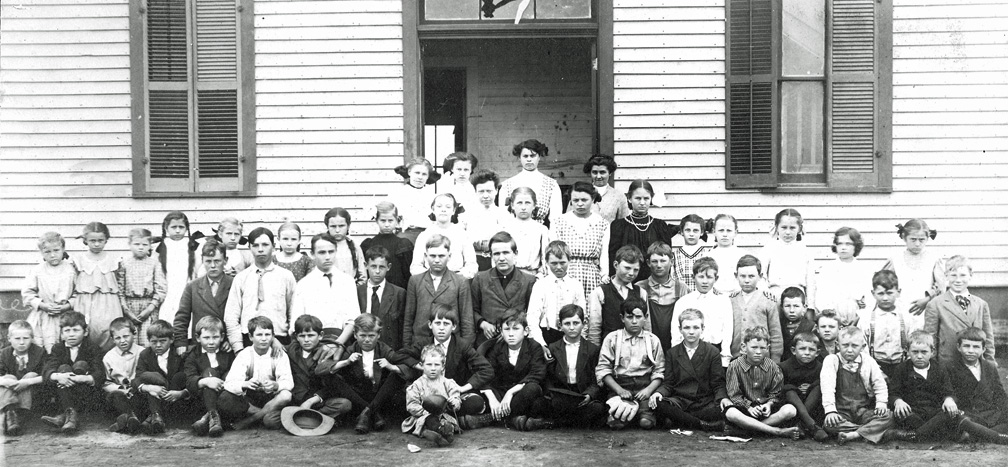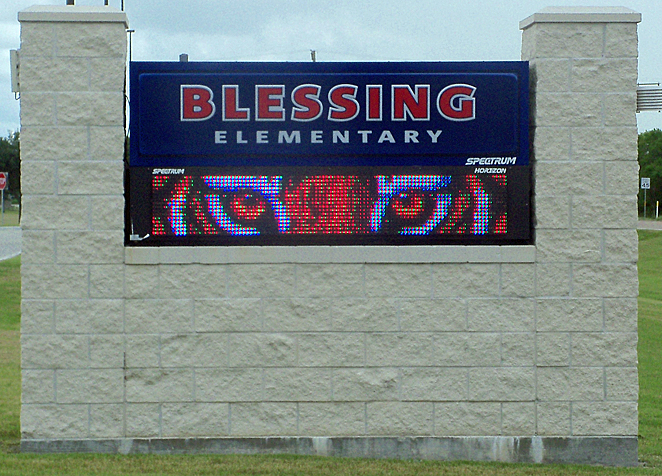|
||
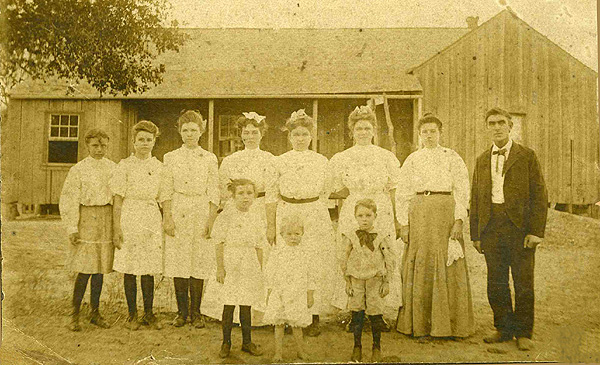 Blessing School - 1903 (If you
can help with identification of students, please
email.) |
||
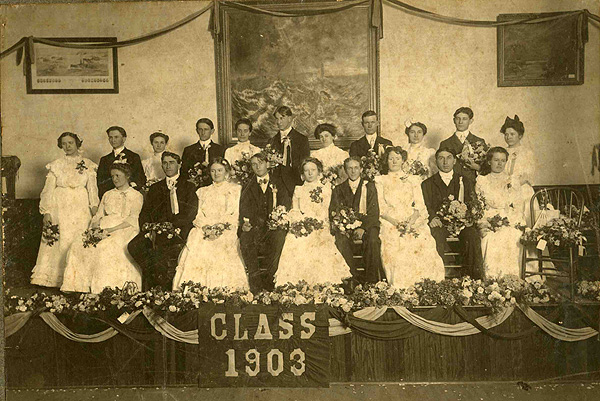 Class of 1903 This picture was labeled Blessing School Class of 1903, but hardly seems possible if the picture above is the Blessing School in 1903. (If you can help with identification of event and students, please email.) |
||
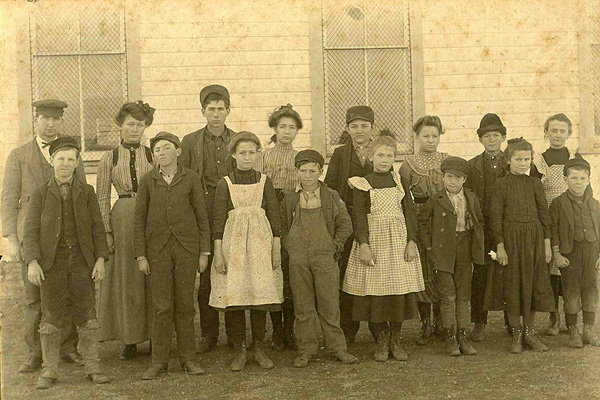 Blessing School - Miss Brown, Teacher (If you can help with identification of students, please email.) |
||
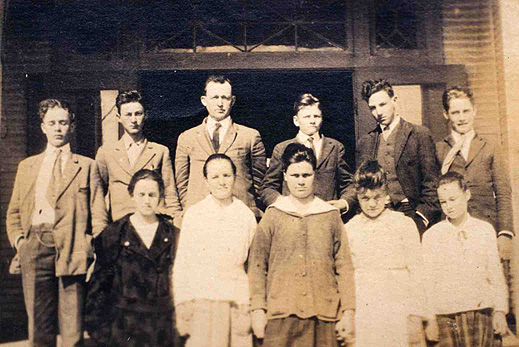 Blessing School - c1913-1915 L. D. Midgett, teacher (back row, third from left) (If you can help with identification of students, please email.) |
||
|
|
||
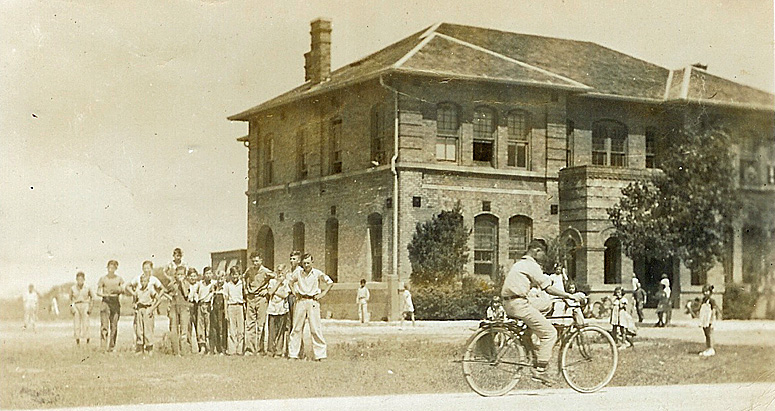 First Brick School Building |
||
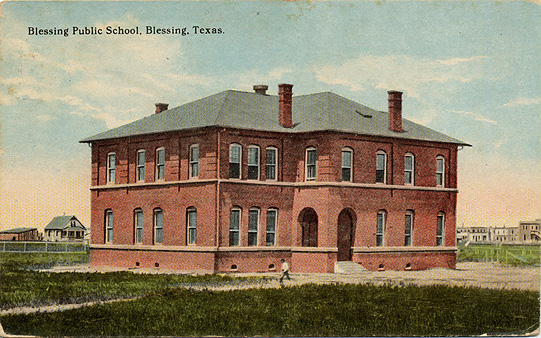 Blessing Public School - Blessing, Texas Card postmarked 1913 |
||
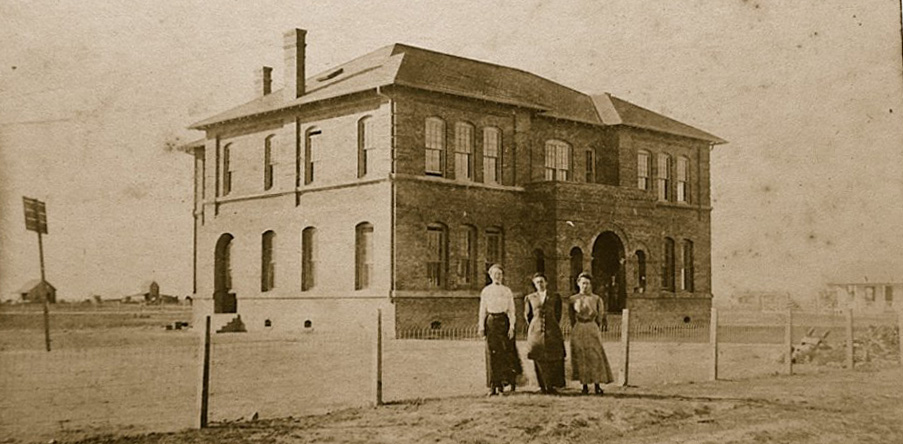 Blessing School - Edna Woodruff on left Picture courtesy of Mark Miller |
||
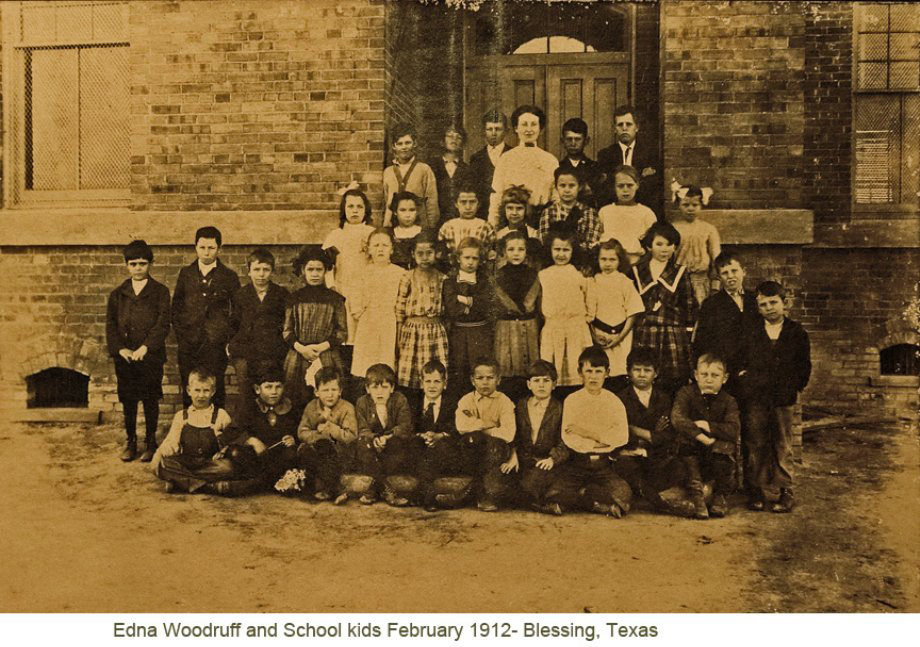 Picture courtesy of Mark Miller |
||
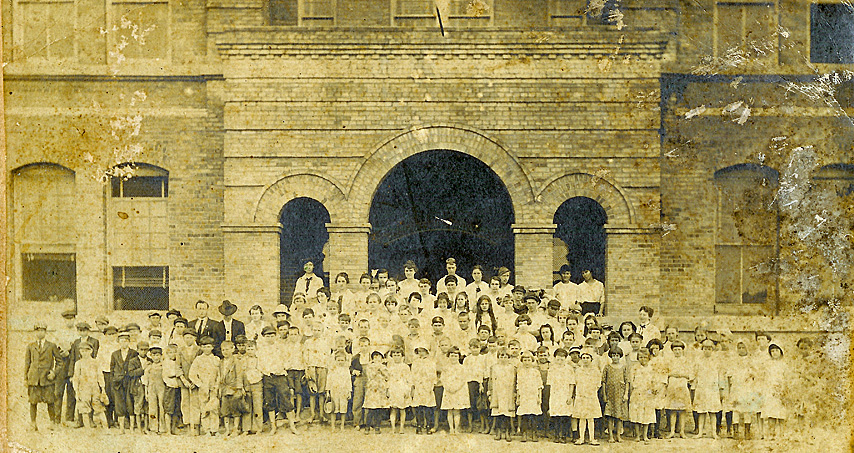 Blessing School 1915 - 1916 Teachers: Mr. Midgett, Miss Woodruff, Miss Bailey, Mrs. Moxley and Miss Meyers |
||
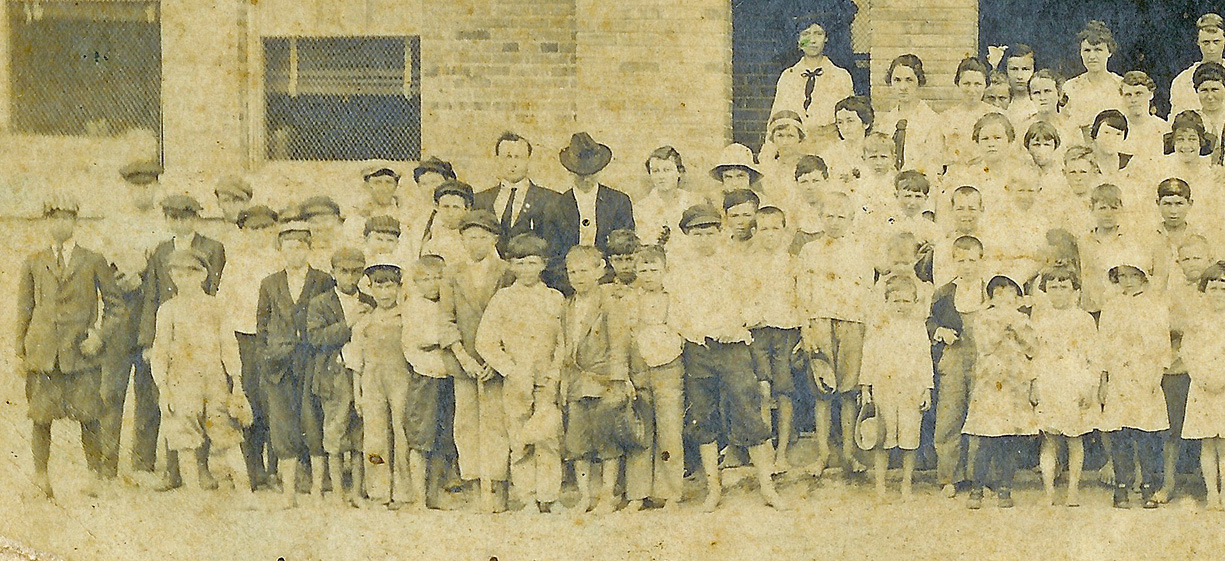 |
||
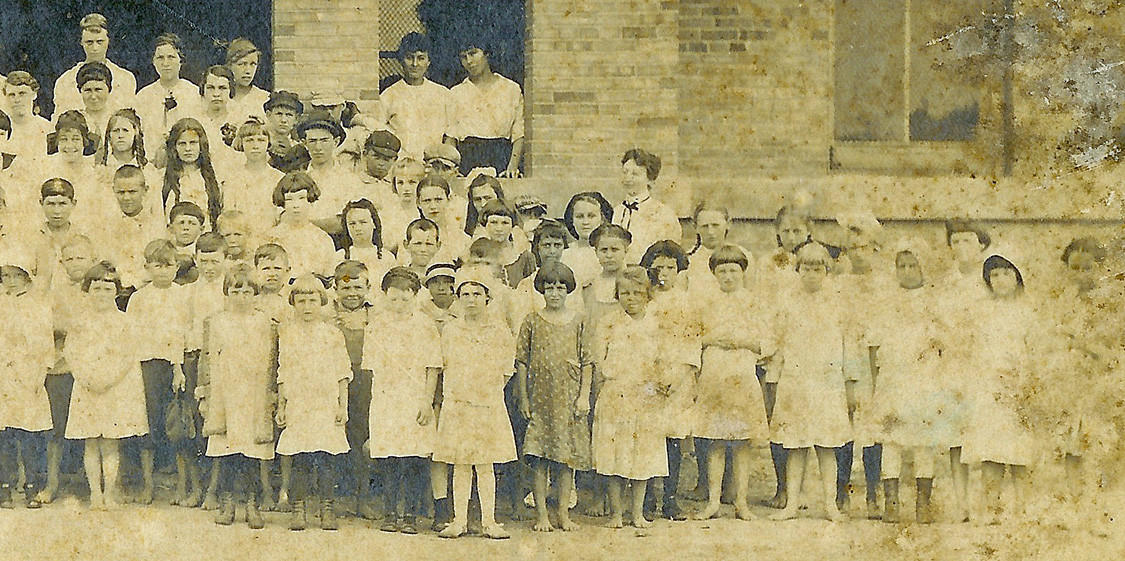 |
||
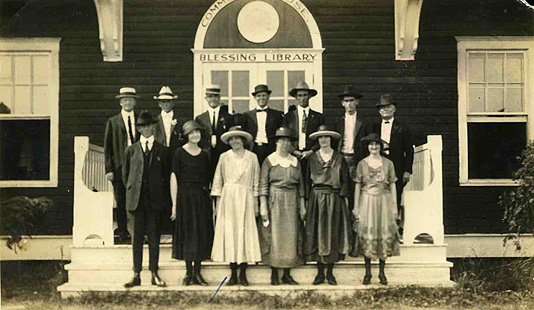 Blessing Teachers and School Board in Front of the Blessing Library and Community House c1918-1922 Front row, teachers, l to r: Ralph Newsom, Francis Harrison, Mary Doss, America Judkins, Beth Wynn, Mary Luder (If you can help with identification of back row, please email.) |
||
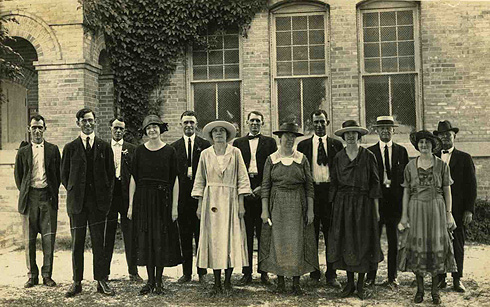 Blessing Teachers and School Board - 1921 Front Row l to r: Ralph Newsom, Francis Harrison, Mary Doss, America Judkins, Beth Wynn, Mary Luder Back Row: School Board Members (If you can identify anyone, please email.) |
||
 Blessing High School |
||
|
Blessing High School constructed in 1935 during the height of the depression and with assistance in building by Federal Funds is the story of leaders of a rural community persevering and building a school that served as a high school until 1951, becoming an elementary school which is still in existence in 2005. The Blessing Independent School District was created as an independent district in July, 1919 by a special act of the 36th legislature, Senate Bill 150, Chapter 64. It then consisted of 30,472 acres and with 39th legislature, Senate bill 366, Chapter 83. By 1934, this district had grown to 62,112.1 acres and was made up of the rural communities of Blessing, Ohio Colony, El Maton, Ashby and Midfield. At that time the school for all grades was a two-story brick building which had been built in 1912 and was situated at 7th Street and Liveoak, facing East. The building was now overcrowded and needing major repairs. As early as 1931 Blessing school board members C. E. Duller (1874-1937) chairman and Adelaide H. Pierce (1885-1967), secretary saw the need to build a new high school and looked into having an election to get a bond passed but realized there wasn't enough money for even the first years expenses so this idea was tabled. The very next year in 1932 the school board decided to build a new school and hired E. L. Steck and Company to draw up the proper paperwork. E. L. Steck and Company prepared the paperwork for the bond election scheduled for November 21, 1933 and material required to get a 30% government grant under the National Reconstruction Act. In addition the Board of Trustees made an application for a loan from the Public Works Administration authorized by the National Industrial Recovery Act for $51,500.50 payable for 30 years. The bond election failed by a vote of 41 for and 63 against. The Assistant State Superintendent, L. L. Dinkins, told the board to have meetings with the residents of the school district to discuss building a new high school whereas they could see the problems of overcrowding and the need for the expanded school district. A second bond election was ordered for February 10, 1934, and the results were 151 for and 84 against. The Board figured the bonds could be paid as follows: $500 per year until 1939, $1000 per year until 1944, $1500 per year until 1949, $2000 in 1961 and $2500 in 1962 and $3000 in 1963 which would be 30 years at 5% interest. Robert E. Black (1901-1997), at age 24 became the superintendent in 1933. A graduate of Rice University he had two years of experience. That year there were seventeen students going into high school and eight who had graduated from high school. Black's salary was $112.50 a month. The school board voted to use 30 cents of each dollar in tax money collected to pay the bonds off. Harry D. Payne (1891-1987), a Houston architect was asked to draw up plans for the new school. Payne had been the architect for Bay City High School (later known at John H. Cherry Elementary) and the Matagorda County Jail. Arthur R Matthes (1898-1976) became president of the board in 1934 and he and secretary Adelaide H. Pierce were appointed to execute papers to get a grant of $14,500 at 4% from the Federal Emergency Administration of Public Works, Washington, D. C. under the National Industrial Recovery Act. R. A. Thompson, State Engineer with Federal Emergency Administration of Public Works would survey the proposed site of the new school and officially selected Harry D. Payne as the architect subject to the approval by Public Works. Bonds totaling $51,000 had to be marketed before Payne could proceed. The first allotment of bonds were sold to the State for $10,000 plus $128.89 interest and the money was deposited in a holding fund at the First National Bank of Bay City, Texas. The location for the new Blessing High School was the portion of land 4.99 acres lying south and west of the southwest leg of the intersecting "Y" of Blessing FM 616 and SH 35, in Lot 3, Block B of the J. E. Pierce subdivision, Josiah Tilley League for which they paid $100.00 per acre. The Board received a basic bid of $47,487.00 from A. N. Evans of Columbus, Texas. Shell drives and paths would cost $436.00 and the increase in floor dimensions and ceiling height added an extra $1,900.00 and $275 making a total of $50,098. Work finally began on the new high school. A notice for the school board was posted that any man residing in Blessing ISD wishing work on the new high school to file his name with the Public Works Administration in Palacios, Texas. Carpenters would get $4.00 per day and helpers $2.00 per day. Harry D. Payne was paid $400 in advance for his work. At this time the school board had $900.12 in the local maintenance fund, $10,128.89 in the building fund and $532.38 in the sinking fund. Other expenses were a basic bid of $6,796.96 for furniture and fixtures with Bickley School and Church Furniture of Houston. The architect's fee was $2,296.21, lawyer fees $500.00. Public Works Administration would have to approve all these bids listed under Docket No. 8380, Engineer reference No. 434. The school board would ask Public Work Administration for 30% of construction and labor as they knew $14,500 would not cover expenses. Architect Payne sent a letter to Norman J. Bering, government attorney in Houston, with approved contracts with the Federal Emergency Administration Public Works to press the school board to begin work. The Spanish style school was to be 163 feet long and 56 feet 9 inches wide with a corridor 9 feet wide running from East to West through the building. On the south side of the corridor was a general science room, boys' showers and restrooms; a stairway passage to the auditorium stage, another stairway passage to the 73' by 45' auditorium, girls' shower and restroom, a cooking and sewing room. On the north side of the corridor was a commercial room, two high school classrooms, teachers lounge, clinic, storeroom, a junior high classroom; a library and a study hall, and a 73' by 45' auditorium. Floors were of composition on cement in the vestibule, lobby and passages. The auditorium, stage, classrooms, office, teachers room, closets would be wood on wood sub floor. The auditorium flooring would be edge grain pine. The walls and ceiling would be plastered. The outside of the building would be brick. Large wooden windows would be placed throughout the building as there was no air conditioning. Work on the school was progressing and they needed to take care of the interior. For the stage curtains in the auditorium, which also served as the gymnasium, the Board voted for a woodland scene typical of certain parts of the lower coast of Texas with velour curtains of dull russet gold to harmonize with the woodwork. Those curtains are still in use. Kitchen utensils, science supplies, a baby grand piano, a second oil stove, a RCA radio and Victrola and eight typewriters were purchased by the board. Landscaping was provided by Japanese Nursery of Genoa, Texas. The finishing touches for the school was a motto submitted by Mrs. Pearl Pierce Smith (1872-1939) and Adelaide Pierce for the front archway entrance and a mural painted by Abel B Pierce, Jr. (1909-2003), son of Adelaide. The motto read, "Enter to Learn - Go Forth to Serve." As you enter the front entrance is the large mural painted by the young Pierce using canvas from a feed store and four colors of house paint depicting a young girl and boy who had visions of their future in the sky. The young lady sees a future in which she is an artist, a ballerina, a nurse, a secretary, or a loving mother. The young man dreams of becoming an airplane pilot, a fiddle player, a rancher, a sailor or a preacher. Both the motto and mural greets children and adults today. The Blessing High School was finally opened and dedicated on September 24, 1935. Matagorda County Judge Oscar Barber (1881-1940), County Superintendent Tom Hale (1903-1969), Architect Harry D. Payne, Attorney C. A. Erickson (1889-1951), C. H. Chermasky from State Board of Education and Mr. L. L. Dinkins, Assistant State Superintendent with other school boards in the county were honored guests at the formal opening. Two plaques, one on either side of the entrance read:
"Blessing High School
Erected A. D. 1935
Arthur R. Matthes, President
Adelaide Hall Pierce, Secretary
Harry D. Payne
Architect
Bickley School & Church Furniture Company Robert Black, Superintendent, resigned March 30, 1936 but continued to teach in the high school until 1966. Warne J. Hallmark of Rockport was hired for the 1936-37 school year at a salary of $143 a month. He served as superintendent until called to active duty by the U. S. Army in 1942. George K. Nelson (1909-1994), a teacher in the school was hired with a three year contract for a monthly salary of $155.50. From 1941, the war years were difficult and Superintendent Nelson had to fill in as principal, teacher, coach and general maintenance due to a shortage of teachers and help. The roof of the high school was leaking as were the septic tanks due to being run over by army trucks. The school was in need of extra money and hired Thomas V. Pickett and Company of Dallas to draw up maps, set up records, evaluate and survey all oil, gas and pipeline property, railroads, utilities and properties at .04 per year of each $100 valuation for a period of two years. A tax election was held and the vote was 57 for and 10 against with wording to say it would not exceed $1.50 per $100 valuation. Times were difficult and money scare for all the rural schools and Blessing ISD had a joint meeting with the Ashby Common School District and Midfield Common School District to discuss consolidation of the three which was agreed on. George K. Nelson was given the contract to be superintendent over the consolidated school district May 1948 and served until August, 1973. Delvin Taska followed as superintendent. By June of 1948 the matter of consolidation was brought up between Blessing ISD and Markham ISD. Both schools boards approved the joint resolution of the two schools and consolidation which read," Whereas the school boards of the Blessing ISD and the Markham ISD have been duty presented with petitions from voters of respective districts praying a consolidated ISD embracing the present area of both districts, selecting trustees to represent all seven districts involved and a new high school to be set up on Highway 35 equal distance between Markham and Blessing. The election was recorded in Volume P, Pages 492-499 Matagorda County Clerk's office. Order of the court November 8, 1948 named the new school Tidehaven Consolidated ISD. Later Consolidated was dropped. Tidehaven High School, named after an early port on the nearby Tres Palacios river was constructed halfway between Markham and Blessing on the open prairie surrounded by farm lands and was opened to students for the 1950-51 term. The old Blessing High School which had served the area for fifteen years was remodeled and became Blessing Elementary School. Maintenance has taken care of the building in a timely manner and the school has been kept in excellent condition. The school is the pride and heart of Blessing. Boy Scouts use the school for meetings and during storms and hurricanes it serves as a shelter. It is a polling place for elections and a meeting place for various community functions.
The motto "Enter to Learn - Go Forth to Serve"
aptly applies to not only the students who attended the old Blessing
High School, but to all the School Board members and residents of a
caring and rural community who have served in the past and those who
continue to serve to have quality education." |
||
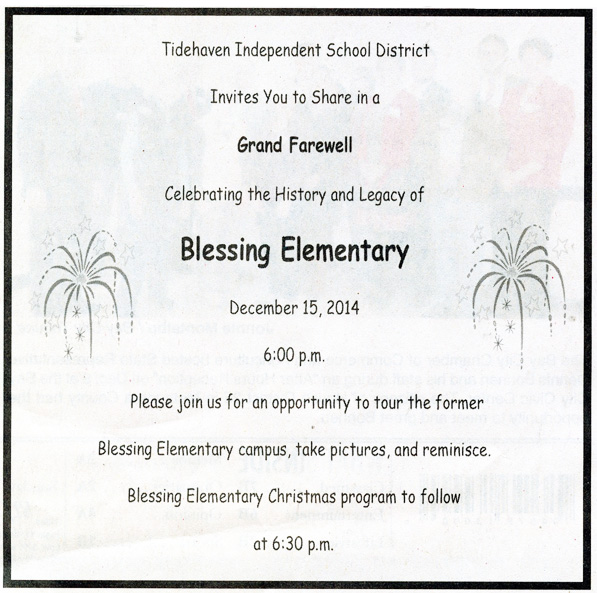 |
|
|
|
|
|
|
|
Copyright 2007 -
Present by Carol Sue Gibbs |
|
| Created Jul. 14, 2007 |
Updated Oct. 2, 2015 |

